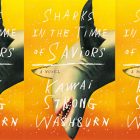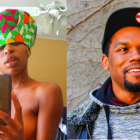“Climate change is coming for us all”: An Interview with Matt Bell

Matt Bell’s Appleseed is a sci-fi novel. It is also a re-imagining of a western, a portrayal of a dystopia, and a techno-adventure. Above all, Appleseed, out tomorrow, is a novel of warning, an air-raid siren of impending environmental collapse, captured in an audacious, interwoven narrative. Appleseed harnesses technology and mythology, reconfigures the story of Johnny Appleseed, recasts Greek fauns, and takes futuristic leaps into printable technologies, all in service of climate awareness, ultimately inviting us to take action, if it isn’t too late.
Brothers Nathaniel and Chapman open the novel traveling through eighteenth-century Ohio. They are committed to planting the wooded frontier with apple orchards, though they work a seed at a time in their dedication to what they see as a means of ripening the land. In part, these men are searching for a hidden truth, a final apple that when grown will heal their familial wounds; the other reason for their seed-sowing is about the world at large, about supporting the landscape in its abilities to provide for humanity. Counter to the typical greed and devastation of westward expansion in the United States, Chapman and Nathaniel are focused on the ultimate symbiosis. As Chapman says: “Abundance everywhere, everywhere gathering and joy and predation and sorrow: amid all this untamed splendor, every acre of forest is an empire in the shape of the world.”
In a second interwoven thread of the novel, we are introduced to John, who lives in a near-future, one in which climate change has ravaged the earth and the natural world is nearly gone. What remains of the landscape is being harvested by Earthtrust, a monolith of a company functioning under the guise of “re-balancing,” but in fact focused secretly on domination, on a particular kind of reformation—reformation in their own covetous image, reformation done using printing looms capable of god-like creations. John must work to counter this domination from inside the company. With the help of his human compatriots and the nanobees he can communicate with digitally, he works to overthrow Earthtrust’s leader and his former lover—Eury. “Even extinction was better than becoming another toy for this woman who had everything,” he says, “who every day owned more of the world.”
Appleseed’s last strand jettisons us one-thousand years into a climate-devastated future, where C-432 uses complex machineries and intricate technologies to survive in and explore the arctic wastelands of North America. He is searching for useable gear and natural resources trapped beneath the earth’s massive ice-sheet. He is also looking for life as it used to be, before beings like C-432, who is more printable extensions than anything else: “So far, C has survived every expedition below the Ice, depending on how precisely you define survive, on how precisely you define C,” we learn. “He remembers more descents than any one life could contain, discrete experiences crushed together by sheer volume, a conglomerate dream of all the lost places he’s been. He has hundreds of cycles’ worth of memories already; if he brings back only more memories, it will not be enough.” If Nathaniel and Chapman represent an idealized past and John our present, C-432 is a prophecy of our dystopia.
Each chapter of Appleseed, each character, each moment is suffused with this warning of impending environmental calamities—environmental calamities of our own creation. The novel isn’t afraid to say it loud and clear. Yet Appleseed also hasn’t forgotten to be a story, to house its message in well-rounded characters and a momentous plot. Hopefully, this will make its pleading more palatable to those who remain skeptical, and will more deeply reach those who need to be called to action. As John’s partner, Cal, says before the final showdown with Eury, “No more solutions delayed, promised by the end of next century. No more by 2150 the sea levels will be this and that height if we do nothing. No more ice deferred, no more pretending the present must be sacrificed for the distant better future never arriving. Make the present the last human world, unless we change everything about how we live, unless we do it together. We can’t keep pretending there’s nothing to do. We act or we do not.”
J. A. Tyler: Appleseed is full of the mythical, the fantastic, the beastly. Where did this novel start for you? What was its first kernel, its first words, its first image?
Matt Bell: It began from the idea of retelling the folk tale of Johnny Appleseed in a more mythological way, with the historical John Chapman recast as a Greek faun—an idea that was prompted by a line in Michael Pollan’s The Botany of Desire, where he called Chapman an “American Dionysus,” which I thought would be fun to take more literally than he meant it. But it also emerged from my concern (and fear) about climate change, from a couple years of reading about industrial agriculture, from growing up in the Midwest as a hiker and a backpacker, and from having spent a lifetime imagining that region’s pre-settler wilderness.
JAT: The novel is very much about the environment, about acting on the warnings and making a choice for our planet. Would you consider yourself an environmentalist? Is Appleseed (in part) a political book?
MB: I would absolutely consider myself an environmentalist, although that should be such a common stance that it’s like saying I’m a human. Shouldn’t we all be environmentalists? I’d also say that Appleseed is a political book, both in the sense that all books are, and also implicitly in its anti-capitalist, anti-techno-utopian leanings. But again, concern about climate change shouldn’t be political or politicized: climate change is coming for us all, whatever our politics, and whatever our politics we better have a plan to face it. Better we do that together than divided, if we can.
JAT: From a craft point of view, was the book always intended to have multiple narratives, or were the separate protagonist threads created in isolation from one another?
MB: I started with the eighteenth-century timeline but the scale opened up pretty early on, although it took a while to find its exact dimensions. Almost as soon as I started writing, I knew I wanted to tell a story spread over a long period of time and taking place in multiple locations, because that’s how climate change works: it’s everywhere, but it’s also not something you can even begin to think about or feel through if you only see its effects in one time and place. Plus it’s fun to tell a big story! Writing a “thousand-year novel” quickly became an exciting challenge, and figuring out how all the timelines intersected and resonated was probably one of the most satisfying parts of writing the book.
JAT: That is a big challenge, especially with a cast split across its many layers. How did you organize that during the writing process? Did you use index cards, sticky notes, or some other method?
MB: Before starting the second draft—the draft that turned out to be the draft where most of the real story got written—I spent a couple months writing an outline of each of the three storylines, with only some idea of how they intersected. I wrote from that outline in thirty-page chunks, alternating between the three timelines in order, which let me see possible points of crossover or juxtaposition as I went, with the outline changing under me as I wrote. Then, when the book was drafted, I edited each timeline on its own until it was good as it could be, then I wove them all back together again. Some of the surprises of the third act were surprises to me too, despite all that planning. I wouldn’t have wanted it any other way.
JAT: In thinking of Kurt Vonnegut’s infamous quote from the 1974 novel Wampeters, Foma and Granfallons—“I have been a soreheaded occupant of a file drawer labeled ‘science fiction’ . . . and I would like out, particularly since so many serious critics regularly mistake the drawer for a urinal.”—I’m wondering how much science fiction influences and shapes your writing, and if you would consider yourself a science fiction writer.
MB: I love science fiction and fantasy, and will happily read it in all its guises: stuff actually labeled SFF, plus the speculative, the genre-bending, the hybrid, the slipstream, and so on. I’m glad to claim to be a science fiction writer, but I think genre labels are more useful to publishers and booksellers than to writers: I never want to be too sure of what I am, especially in any way that might exclude new directions.
Maybe the most illustrative story I can tell about this is from when we were selling the book. One editor I talked to told me, “This is pure science fiction, not like your literary stuff at all,” and I said, “Sure!” And the next editor said, “This is absolutely literary fiction, not sci-fi,” and I said: “Sure!” It doesn’t matter that much to me how a reader categorizes the book if they’re enjoying it. That said, the major literary influences on Appleseed were SFF writers like Ursula K. Le Guin, Iain M. Banks, N.K. Jemisin, William Gibson, and Nnedi Okorafor—and if I thought my book could be counted among theirs, I’d be a happy writer.
JAT: You’re also a big video gamer. How do those games and their narrative approach color or shape a work like Appleseed?
MB: I don’t know if there’s anything particularly direct that I can point to, except maybe in my vehicle design and architecture. Video games and sci-fi movies encouraged me to run with certain ideas, to make them ostentatious and exciting and large-scale, rather than more dully practical or “believable”—what would Star Wars or any number of video game levels be without dangerous catwalks and yawning chasms and an utter lack of guardrails? Everything has to serve a function in the story, but whenever I could get away with it, I also wanted my buildings and vehicles and technologies to generate awe and wonder. That certainly helped with the design of thing’s like the Earthtrust Tower, or the translucent photovoltaic bubble craft [where] C spends his time, or the way the Loom functions, which is probably a little more ostentatious than a bioprinter really needs to be.
JAT: Are the animals of the novel intended in that way too, as ostentatious rather than practically considered? Your debut novel, In the House Upon the Dirt Between the Lake and the Woods, includes animals as well. What draws you to animals and beasts, real or mythological?
MB: There probably are ostentatious animals in the book, like the witch-beasts in Chapman’s timeline, but I hope most of the nature writing in the book is concrete and specific and fill of mundane wonder. One of the things I believe most fervently is that nature needs very little adornment, that the phenomenal nature of the everyday is already spectacular. So nature doesn’t need me to dress it up! I think I’m drawn to animals for reasons as simple as basic affection and as complicated as their symbolic possibilities in myth and folk tale and dream. I’ve written a lot about people interacting with animals (or becoming them), and I think the crossover between the human and nonhuman is likely to always be fuel for my imagination.
JAT: Much of Appleseed rests in or takes from mythology, from fairy tale roots. What is your favorite fairy tale or myth? Who is your favorite contemporary author playing with or riffing on fairy tales?
MB: Appleseed is built on a few favorites! The myth of Orpheus and Eurydice (and the faun/satyr wedding guest who kicks off the tragedy at their wedding), the folktale of Appleseed, the biblical story of the Garden of Eden. I’ve always loved Red Riding Hood and Rumpelstiltskin and Baba Yaga, among so many others.
Kate Bernheimer is my favorite writer of fairy tales, and my favorite thinker regarding the qualities and possibilities of the form, in both new and old tales. I should say that I never think of her as “playing” or “riffing” on fairy tales: she’s simply working in the form, like many other contemporary writers.
JAT: The novel’s characters are often either struggling to keep hope alive, or keep those around them hopeful. Do you have hope for our environment, for our climate, for the future of the earth?
MB: Hope for the future of life on earth is different than hope for the future of humanity. We’re doing a good job making life unlivable for ourselves and for a lot of animals and plants. But there will, I think, always be life in the future. That’s my first hope. The decision we have to make now is about whether we want to be a part of that future life, and how much damage we’re willing to do to ourselves and others along the way to arriving there. I do think there are signs that the actions we need to take are becoming more possible, in ways that seemed unlikely a few years ago, but there’s no way to hide from the fact that the clock is ticking faster than we’re moving.
This piece was originally published on July 12, 2021.



